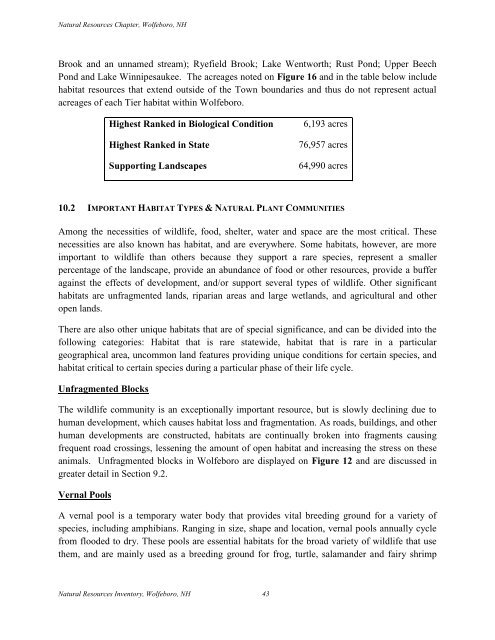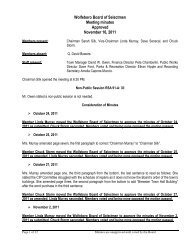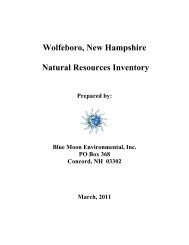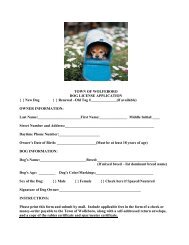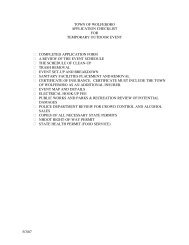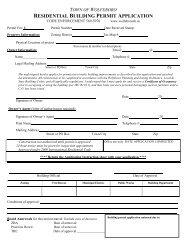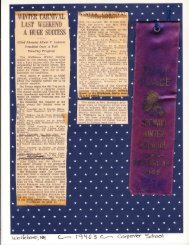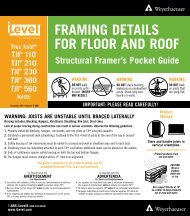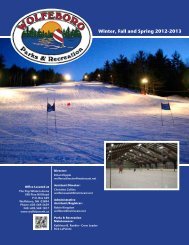Natural Resources Chapter of the Master Plan - Town of Wolfeboro
Natural Resources Chapter of the Master Plan - Town of Wolfeboro
Natural Resources Chapter of the Master Plan - Town of Wolfeboro
You also want an ePaper? Increase the reach of your titles
YUMPU automatically turns print PDFs into web optimized ePapers that Google loves.
<strong>Natural</strong> <strong>Resources</strong> <strong>Chapter</strong>, <strong>Wolfeboro</strong>, NH<br />
Brook and an unnamed stream); Ryefield Brook; Lake Wentworth; Rust Pond; Upper Beech<br />
Pond and Lake Winnipesaukee. The acreages noted on Figure 16 and in <strong>the</strong> table below include<br />
habitat resources that extend outside <strong>of</strong> <strong>the</strong> <strong>Town</strong> boundaries and thus do not represent actual<br />
acreages <strong>of</strong> each Tier habitat within <strong>Wolfeboro</strong>.<br />
Highest Ranked in Biological Condition<br />
Highest Ranked in State<br />
Supporting Landscapes<br />
6,193 acres<br />
76,957 acres<br />
64,990 acres<br />
10.2 IMPORTANT HABITAT TYPES & NATURAL PLANT COMMUNITIES<br />
Among <strong>the</strong> necessities <strong>of</strong> wildlife, food, shelter, water and space are <strong>the</strong> most critical. These<br />
necessities are also known has habitat, and are everywhere. Some habitats, however, are more<br />
important to wildlife than o<strong>the</strong>rs because <strong>the</strong>y support a rare species, represent a smaller<br />
percentage <strong>of</strong> <strong>the</strong> landscape, provide an abundance <strong>of</strong> food or o<strong>the</strong>r resources, provide a buffer<br />
against <strong>the</strong> effects <strong>of</strong> development, and/or support several types <strong>of</strong> wildlife. O<strong>the</strong>r significant<br />
habitats are unfragmented lands, riparian areas and large wetlands, and agricultural and o<strong>the</strong>r<br />
open lands.<br />
There are also o<strong>the</strong>r unique habitats that are <strong>of</strong> special significance, and can be divided into <strong>the</strong><br />
following categories: Habitat that is rare statewide, habitat that is rare in a particular<br />
geographical area, uncommon land features providing unique conditions for certain species, and<br />
habitat critical to certain species during a particular phase <strong>of</strong> <strong>the</strong>ir life cycle.<br />
Unfragmented Blocks<br />
The wildlife community is an exceptionally important resource, but is slowly declining due to<br />
human development, which causes habitat loss and fragmentation. As roads, buildings, and o<strong>the</strong>r<br />
human developments are constructed, habitats are continually broken into fragments causing<br />
frequent road crossings, lessening <strong>the</strong> amount <strong>of</strong> open habitat and increasing <strong>the</strong> stress on <strong>the</strong>se<br />
animals. Unfragmented blocks in <strong>Wolfeboro</strong> are displayed on Figure 12 and are discussed in<br />
greater detail in Section 9.2.<br />
Vernal Pools<br />
A vernal pool is a temporary water body that provides vital breeding ground for a variety <strong>of</strong><br />
species, including amphibians. Ranging in size, shape and location, vernal pools annually cycle<br />
from flooded to dry. These pools are essential habitats for <strong>the</strong> broad variety <strong>of</strong> wildlife that use<br />
<strong>the</strong>m, and are mainly used as a breeding ground for frog, turtle, salamander and fairy shrimp<br />
<strong>Natural</strong> <strong>Resources</strong> Inventory, <strong>Wolfeboro</strong>, NH 43


